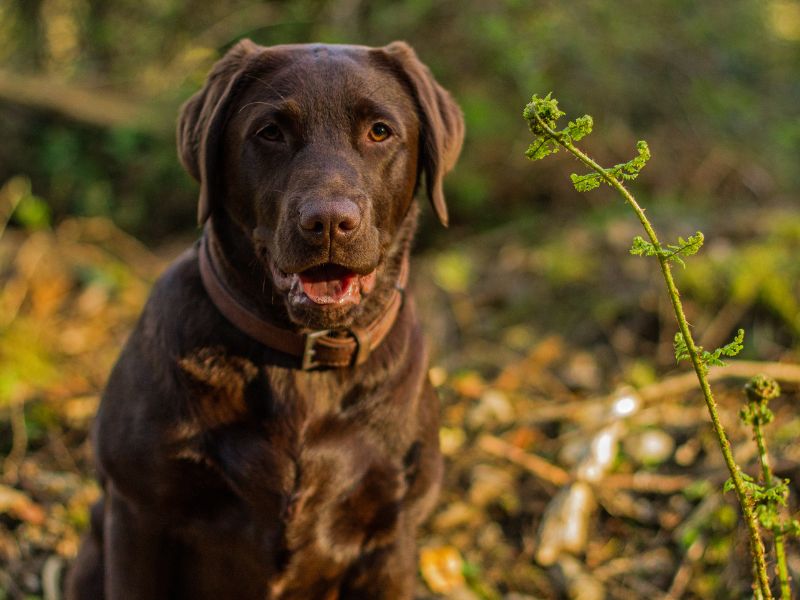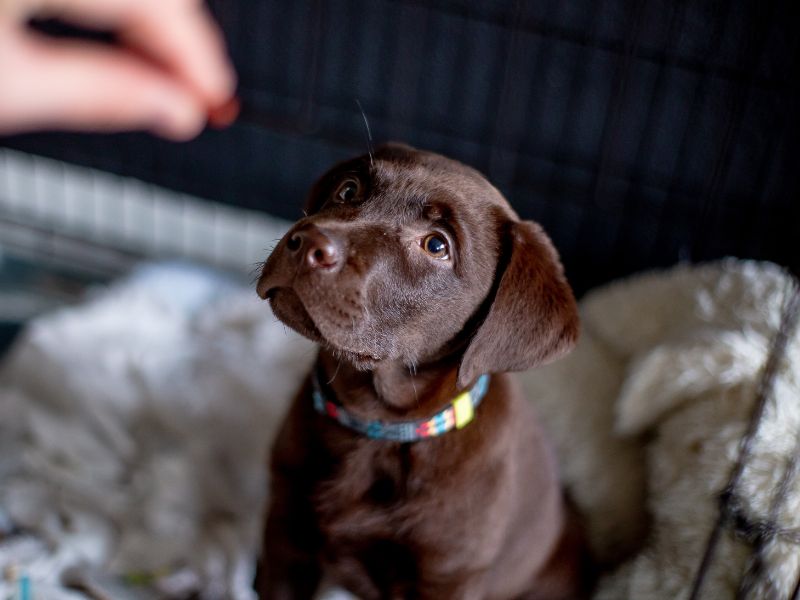
The Chocolate Lab, a popular variant of the Labrador Retriever breed, is well-known for its stunning brown coat and friendly, confident demeanor that makes them a sought-after companion. Although not a separate breed, Chocolate Labs have a unique color variation within the purebred Labrador Retriever lineage, showcasing hues ranging from light brown to deep mahogany. Standing at a height of 21.5 to 24.5 inches and weighing between 55 to 80 pounds, these medium-to-large-sized dogs boast a robust physique, a water-resistant double coat, and a wide muzzle. Their loving disposition and charm make them a favorite choice for dog enthusiasts, despite recent studies raising concerns about their health compared to their yellow and black Lab counterparts. While Chocolate Labs were officially recognized as a standard color in Labrador Retrievers as far back as 1917, it wasn’t until the 1960s that they started gaining widespread popularity. Today, these affectionate and faithful dogs continue to win hearts around the globe, cementing their place in the Labrador Retriever family. Interesting Tidbits About Chocolate Labs

The Chocolate Labrador is a delightful and lively breed of dog, known for its friendly and playful personality. These dogs typically weigh around 80 lbs and stand at approximately 24 inches tall. They are clever and confident pets that are favored by families and sports enthusiasts, with an average lifespan of around 12 years. Sharing many physical traits with other Labrador Retrievers, Chocolate Labs have a sturdy build, a thick double coat, and a broad snout. Their most unique feature is their rich brown fur, resembling that of delicious chocolate. Standing a bit taller and weighing more than their black or yellow counterparts, Chocolate Labs are slightly larger in size. While not as common, their popularity is on the rise due to genetic testing advancements. Renowned for their sociable and amiable nature, these dogs are a great addition to any household. Their expressive eyes and floppy ears only add to their charm, making them beloved companions. As active sporting dogs, Chocolate Labs need regular exercise and mental stimulation to thrive. Daily walks, playtime, and training sessions are necessary to keep them healthy and content. When considering a Chocolate Lab as a pet, it’s important to understand their characteristics, physical traits, and exercise requirements to ensure a good match with their new family. Take Rachael, a stunning three-year-old Chocolate Labrador with a mix of American and English Lab genes, for example, showcasing the allure of this breed. Despite common misconceptions about their intelligence, Chocolate Labs are just as smart and affectionate as their counterparts. With a range of brown shades in their fur, noses, eyes, and skin, these dogs exude a special charm and individuality. In essence, Chocolate Labs, like Rachael, are remarkable companions admired for their distinctive appearance and amiable demeanor. Their intelligence, temperament, and unique look contribute to their growing popularity among dog enthusiasts.

Chocolate Labs, also known as Chocolate Labrador Retrievers, have a rich history that dates back to the 1500s in Newfoundland. The breed was developed through selective breeding as European fishers traveled to the Atlantic for food, resulting in the creation of the Labrador Retriever. While black Labs were the most common, some carried the gene for producing chocolate puppies. The chocolate color in Labs is inherited through a recessive gene from both parents, resulting in various shades of brown with matching eyes and nose. Chocolate Labs are one of the three main colors of Labrador Retrievers, alongside black and yellow. Understanding the genetics behind coat color inheritance in Labradors is crucial for breeders and potential owners. Specific genes, epistasis, and multiple gene interactions all play a role in determining whether a Labrador will have a black or chocolate coat. These lovable dogs are known for their friendly and energetic personalities, making them ideal as family pets or sporting companions. Their coat color may change over time due to factors such as sunlight exposure and aging, but proper grooming and care can help maintain their appearance without impacting their well-being or temperament. Despite being less popular in the past due to misconceptions and rarity, advances in genetics and breeding have increased the popularity of chocolate Labs. Today, they are prized for their intelligence, loyalty, and ease of training, making them wonderful companions for families and individuals alike.

Wondering about the size of a Chocolate Lab? Typically, they range from 21.5 to 24.5 inches in height and weigh between 55 to 80 pounds. These medium to large dogs are known for their athletic bodies and chocolate-colored fur, making them stand out from yellow and black Labs. Their affectionate and sociable temperament makes them a beloved choice for both families and as working companions. It’s worth mentioning that Chocolate Labs may have a higher susceptibility to health issues like hip dysplasia, vision problems, and an increased risk of cancer compared to other Lab breeds.

Is it a common myth that Chocolate Labrador Retrievers are not as smart as Labs of other colors? Despite this misconception, the reality is that all Labs, regardless of color, exhibit similar levels of intelligence and potential. By choosing a responsible breeder and offering proper training and socialization, a Chocolate Lab can be just as clever and trainable as a black or yellow Lab. Don’t underestimate a Chocolate Lab’s intelligence based on their fur color – with proper breeding and care, they are just as sharp and adept as any other Lab.

Despite misconceptions about their intelligence, Chocolate Labs are truly an amazing breed. The color of their coat does not determine how smart or trainable they are. Every Labrador, regardless of their color, has the potential to be smart and hardworking. There are various shades of Chocolate Labs, from light liver to dark mahogany, all adding to the beauty of this popular breed. Genetics and breeding practices can influence the specific shade of a Chocolate Lab’s coat. Proper training, mental stimulation, and upbringing are key factors in shaping a Chocolate Lab’s behavior. While some may view them as stubborn, it’s important to note that a dog’s temperament can be influenced by individual factors, not just their coat color. Silver Labs, a unique variation of Chocolate Labs, have a striking silver coat color due to a dilute gene. Despite their distinct appearance, Silver Labs share the same friendly and lively temperament as other Labradors, winning over families and dog lovers alike. In general, Chocolate Labs have a bright future ahead. Their friendly and fun-loving nature makes them a popular choice for many families. Their adaptability in both family settings and sports, paired with their gorgeous brown coat and lovable personality, make them a delightful addition to any household.

Acquiring a Chocolate Labrador puppy can be an exciting endeavor, but it’s essential to conduct thorough research and locate a trustworthy breeder to ensure you welcome a healthy and well-bred puppy into your home. While Chocolate Labs are not as common as their yellow and black counterparts, there are options available for those interested in adding this beautiful color variation to their family. A great alternative to purchasing from a breeder is to consider adopting a Chocolate Lab from a shelter or rescue organization. Many dogs, including Chocolate Labs, are in need of loving homes, and adopting from a shelter can be a fulfilling experience. Explore local rescue groups or Labrador-specific rescues to see if any Chocolate Labs are available for adoption. If you opt to buy a puppy from a breeder, it’s crucial to do your homework. Seek out breeders who prioritize ethical breeding practices and the well-being of their dogs. Expect to pay a higher price for a Chocolate Lab puppy, as they are considered a rarer breed and can cost anywhere from $1,000 to $2,250, depending on the quality of the puppy and its intended use, such as for show competitions. When reaching out to breeders, inquire about the health background of the puppy’s parents and ask about any genetic testing results available. Due to their unique coat color resulting from a specific genetic combination, it’s vital to ensure the breeder adheres to ethical standards and provides accurate information and assistance throughout the process. Furthermore, establish connections within the Labrador Retriever community to increase your chances of finding a reputable breeder or learning about potential adoption options for a Chocolate Lab. Attending dog shows, connecting with fellow Labrador owners, and engaging in online forums can all facilitate your search for the ideal Chocolate Lab puppy. Whether you decide to adopt or purchase a Chocolate Lab puppy, by dedicating time to find a reputable breeder or rescue organization, you will bring home a devoted and affectionate companion that will enhance your life for years to come.

In order to smoothly introduce a Chocolate Lab puppy into your household, it is important to do your homework beforehand. Start by finding reputable breeders or adoption centers nearby. Consider adopting a Chocolate Lab from a shelter or rescue organization as a fulfilling option. When choosing a breeder, make sure they follow ethical breeding practices and prioritize the well-being of their puppies. Avoid purchasing from pet stores or online ads, as these could be linked to puppy mills. Chocolate Labs are not a distinct breed, but rather a Labrador Retriever with a chocolate coat. Their prices typically range from $800 to $1200, based on factors like pedigree, location, and demand. When selecting a Chocolate Lab puppy, focus on their temperament and overall health. Look for a puppy that is curious, friendly, and energetic. Ask the breeder about any potential health issues, as studies show that Chocolate Labs may have slightly higher health risks than yellow or black Labs. It is crucial to visit the breeder’s facility and meet the puppy’s parents to assess their temperaments and living conditions. This will give you insight into the behavior and possible health concerns of your Chocolate Lab puppy. Despite being susceptible to certain health issues like ear infections, Chocolate Labs are intelligent and capable dogs. To increase the chances of getting a smart and healthy puppy, choose a breeder who provides documentation of the dog’s lineage and relevant health tests. After bringing your Chocolate Lab puppy home, make sure to schedule regular vet check-ups, provide proper nutrition, and give them plenty of exercise to minimize health risks. Watch for any changes in behavior or health that may indicate a problem, and seek advice from your vet when necessary. Although Chocolate Labs face specific health challenges due to their color, with proper care and attention, they can live a happy and healthy life. Potential owners should familiarize themselves with these concerns and work closely with veterinarians to address any issues that may arise.

While Chocolate Labradors may have a slightly shorter lifespan compared to other Lab colors, there are ways to help your furry friend live a long and healthy life. Regular health checkups are important for catching any potential health issues early on, and following your vet’s recommendations for vaccinations is crucial in preventing diseases. Maintaining a healthy weight is vital for Chocolate Labs to prevent various health problems. A proper diet and regular exercise can help keep your dog at a healthy weight, avoiding obesity and joint issues. When choosing a Chocolate Labrador puppy, it’s essential to select a breeder who practices ethical breeding and conducts genetic testing for hereditary conditions to prevent future health problems. Training and exercise are key for a happy and well-behaved Chocolate Labrador. Early training and consistent routines can help your dog become a well-behaved member of your family. Socialization, basic commands, and positive reinforcement are essential components of effective training. Teaching your Chocolate Lab to greet people calmly can prevent over-excitement, and training them to sit and stay when meeting new people can help them interact appropriately with others. Daily walks, play sessions, and mental stimulation are crucial for maintaining the health and happiness of your Chocolate Labrador. Activities like fetch, swimming, hiking, and participating in dog sports can prevent boredom and excessive weight gain. As your Chocolate Lab grows older, continue to provide them with proper care, regular vet checkups, a healthy diet, and suitable exercise to ensure they have a comfortable and happy old age.

As Chocolate Labradors age, they may face new health challenges that require extra attention and care. It’s crucial to ensure their comfort and well-being, especially as they become less agile and more susceptible to illnesses. Adapting your home to accommodate the needs of an older Chocolate Lab is key. Adding non-slip surfaces in areas where your dog spends time can help prevent accidents, as their balance may not be as reliable as before. Regular grooming is essential for keeping an older Chocolate Lab’s skin and coat in good shape. Opt for gentle, brief grooming sessions using a soft brush to avoid irritation, and check for pests like fleas and ticks with a fine-toothed comb. Monitoring your dog’s diet and exercise routine is important to maintain a healthy weight and prevent obesity-related issues. Since older dogs are typically less active, they may require fewer calories, so adjusting their food intake is necessary. Seeking advice from your vet can help in designing the best diet plan for your senior Chocolate Lab. Regular visits to the veterinarian are crucial for detecting any potential health issues early on. Taking your elderly Chocolate Lab to the vet for a thorough check-up at least twice a year can help catch and address any problems before they worsen. Chocolate Labs are a unique variant of the Labrador Retriever, recognized for their stunning chocolate-brown fur. These affectionate, confident, and sociable dogs are beloved for their charming looks. Physically, Chocolate Labs share similar traits with other Labradors, such as a robust build, a double coat, and a gentle expression. What distinguishes them is their beautiful brown coat, which is their most notable feature. Along with their coat color, Chocolate Labs are known for their athleticism and vitality, making them excellent companions for active households. They relish water activities, fetching games, and outdoor escapades. While Chocolate Labs are generally healthy, it’s important to be mindful of potential health issues that may be more prevalent in this color variation. Being aware of these concerns can help ensure your Chocolate Lab enjoys a happy and healthy life for many years.




